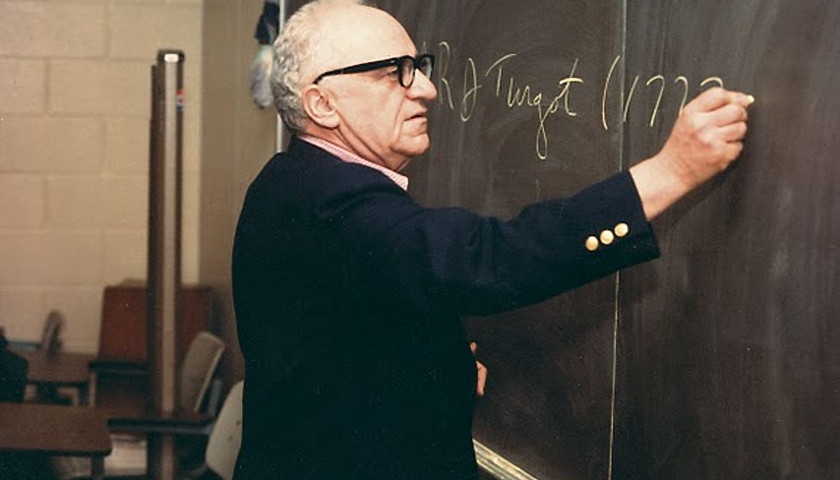by Silvio Simonetti
More than 20 years after his death, Murray Rothbard continues to surprise us with his unique interpretations and insights that go far beyond the realm of economics. Rothbard’s The Progressive Era, (Mises Institute, 2017) is the latest example of this genial mind ranging over U.S. history.
Rothbard’s book is a series of different studies, some already published and others not, written over decades, which focus on the Progressive Era and its direct consequence, President Franklin D. Roosevelt’s New Deal.
Over some 550 pages, Rothbard shows us how, at the end of the 19th century, the United States underwent intense political and social transformations that reshaped the intellectual horizons of the nation and opened the doors to the creation of an administrative state equidistant from both democratic control and the legal framework established by the Founding Fathers.
The progressive movement was undoubtedly full of nuances, with various tendencies that sometimes overlapped and other times repelled each other. The populist progressivism of the Midwest, for example, was isolationist and suspicious of big corporations and the Federal government’s bureaucracy. On the other hand, West Coast progressives were more determined to advance a radical agenda of social reforms. What united them was the common belief in the power of the new science of public administration and the rise of the social engineer. In this view, modern industrial society’ new paradigms demanded the application of the principles of the natural sciences to political life.
It is interesting to note how Rothbard’s libertarian interpretation of the birth of progressivism as a political movement is similar to those made by leftist intellectuals such as historian Gabriel Kolko and sociologist C. Wright Mills, both of them extremely popular with the New Left of the 1960s. Rothbard’s book details how the interests of large industries were paramount for the rise of federal regulation over the economy, starting with railroads and culminating in the creation of the Federal Reserve during the Woodrow Wilson’s administration. In Rothbard’s account, we have the opportunity to observe the power of the political and economic elites in full swing, shaping the American public opinion in favor of the concentration of power in Washington to ensure that their authority will never be challenged.
Probably the most exciting part of the book is Rothbard’s analysis of the electoral behavior of the American population in the second half of the 19th century. According to him, what determined the voting patterns was the voters’ religious background. Some Protestant denominations adhered to Pietism, favoring the use of the state as a divine instrument to purge the sins of society and, consequently, voting on politicians who supported social reform. On the other hand, Catholics and high Lutherans were described by Rothbard as Ritualists who cared more about theological issues than individual behavior and tended to vote for candidates who favored personal freedoms and, therefore, free markets and small government.
Rothbard elaborates on the political dynamics at the end of the 19th century regarding the Ritualists and Pietists. The first group generally supported the Democratic Party — at that time the party of laissez-faire — while the second group closed ranks with the Republicans. Through this period, Rothbard observes a great balance in the electoral disputes, with Republicans being slightly favored. This correlation of forces changed when Pietists led by William Jennings Bryan took over the Democratic Party, making the Ritualists support the Republican William McKinley, resulting in the first sound electoral victory since Ulysses Grant’s election in 1868.
The Pietistic-Progressive movement reached its highest power with the United States’ entry into World War I under President Woodrow Wilson’s strong messianic rhetoric and his idea of making the world “safe for democracies.”
Rothbard’s interpretation according to which Wilsonian foreign policy was an outgrowth of the pietistic internal politics of social reform foreshadowed in two decades the conclusions of the eminent historian Richard Gamble in The War for Righteousness. Nevertheless, Gamble’s book was published in 2005, Rothbard’s manuscript was written years before although published only in 2017.
It is impossible to read The Progressive Era and not to think about the situation of the United States today, in particular, and the Western world, in general.
Rothbard wrote about the period when the Power Elite, to use C. Wright Mills expression, began its long march toward almost total control of American politics through the bureaucratic state. More than 150 years after the first Progressive reformers started their campaign to reshape government, laws, and politics, we see the President of the United States wholly besieged by a bureaucracy that cannot be controlled and works daily to undermine his political agenda. In modern America shaped by progressivism, voting has become a completely powerless means of changing anything.
However, one of Rothbard’s greatest merits is to make us realize that the modern American right ditched the Old Right’s priority about to roll back the state’s frontiers, and nowadays is almost entirely dominated by the worldview once championed by Woodrow Wilson’s pietist progressives. The neoconservatives, who have pushed the United States into disastrous wars in the Middle East to spread liberal democracy, are the heirs of the simplistic thinking of those who once dreamed of turning government into a representative of God’s will on earth.
American conservatives would be far more effective if they adopted the Old Right’s priorities in fighting the Government’s Pantagruelian appetite for power that has been eroding individual freedoms and moral life, rather than to be friends of the deep state and all sorts of corporative interests.
– – –
Silvio Simonetti is a Brazilian lawyer, graduated in international affairs from the Bush School at Texas A & M University. He is currently a Research Fellow at the Acton Institute. Silvio loves history and the Catholic Church.
Photo “Murray N. Rothbard” by LvMI. CC BY 3.0.





